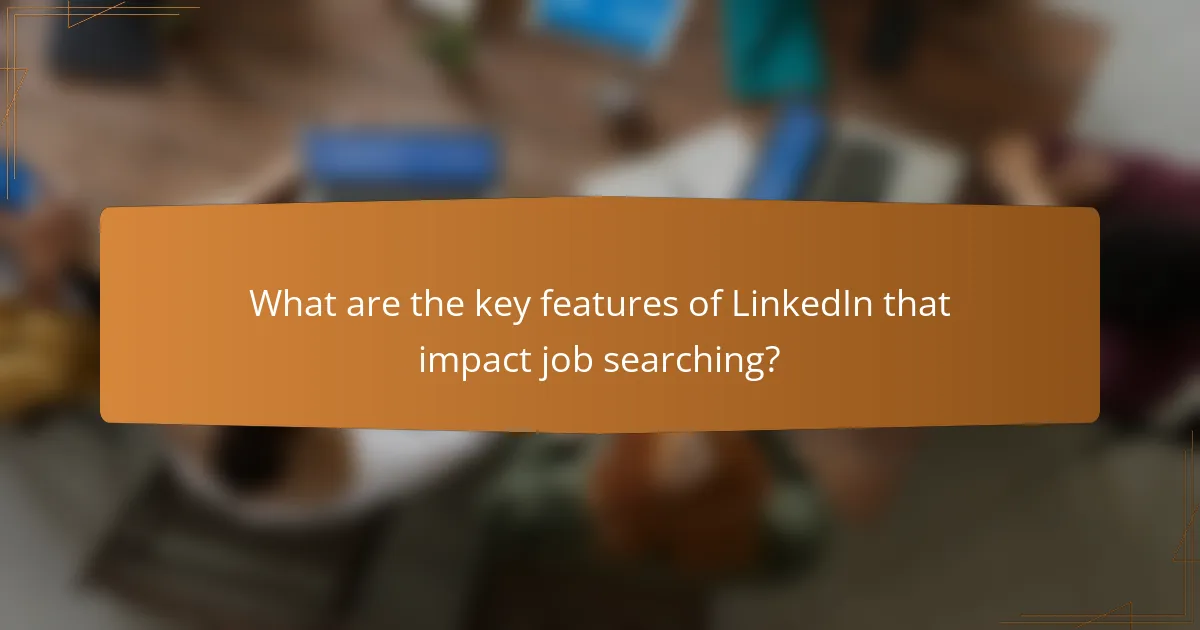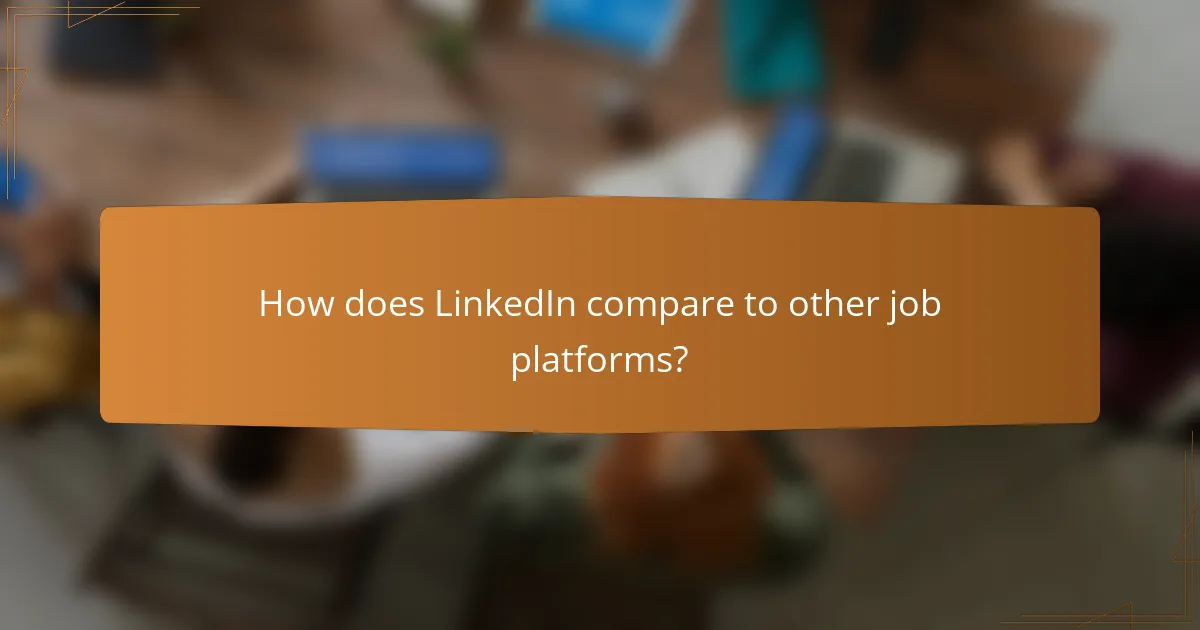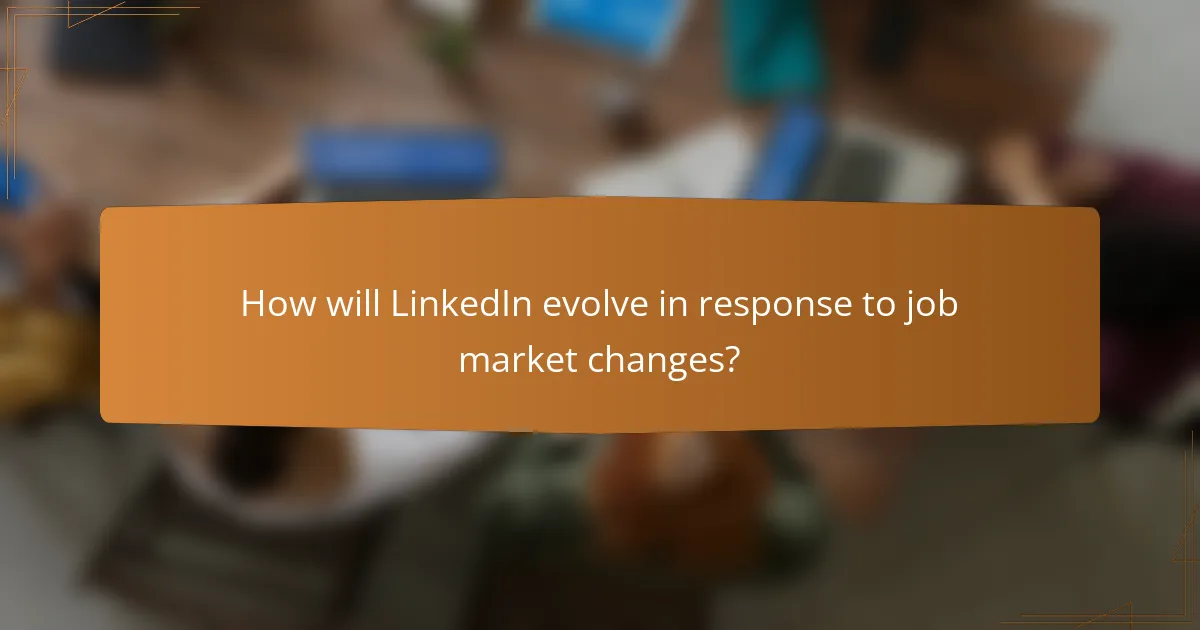LinkedIn plays a pivotal role in shaping job market trends by increasing job visibility and facilitating efficient hiring processes. The platform not only allows job seekers to showcase their skills but also provides valuable insights into employment dynamics through data analysis of user activity and job postings. By leveraging LinkedIn’s resources, professionals can enhance their career prospects and adapt to the evolving demands of the job market.

How is LinkedIn shaping job market trends in the United States?
LinkedIn significantly influences job market trends in the United States by enhancing job visibility, promoting data-driven hiring, and facilitating professional networking. Its platform allows job seekers to showcase their skills while helping employers find qualified candidates more efficiently.
Increased visibility for job seekers
LinkedIn provides job seekers with a platform to enhance their visibility to potential employers. By creating a comprehensive profile that highlights skills, experiences, and endorsements, candidates can attract attention from recruiters actively searching for talent.
Job postings on LinkedIn often receive higher engagement compared to traditional job boards, as users can easily apply and share opportunities within their networks. This increased visibility can lead to more interview invitations and job offers.
Data-driven hiring practices
Employers are increasingly relying on LinkedIn’s data analytics to inform their hiring decisions. The platform offers insights into candidate skills, industry trends, and salary benchmarks, allowing companies to make informed choices based on real-time data.
For example, recruiters can analyze the skills most commonly associated with successful employees in their industry, helping them refine their search criteria. This data-driven approach can lead to better hiring outcomes and reduced turnover.
Networking opportunities for professionals
LinkedIn serves as a powerful networking tool for professionals across various industries. Users can connect with peers, join industry-specific groups, and participate in discussions, which can lead to new job opportunities and collaborations.
Engaging with content shared by others in your field can also enhance your visibility and establish your expertise. Regularly posting updates, sharing articles, or commenting on discussions can help build a robust professional network that may prove invaluable in your job search.

What insights can LinkedIn provide about job market dynamics?
LinkedIn offers valuable insights into job market dynamics by analyzing user activity, job postings, and hiring trends. This data helps professionals and organizations understand shifts in demand, skills required, and overall employment patterns.
Real-time labor market data
LinkedIn’s real-time labor market data reflects current job openings, hiring rates, and workforce trends. This information is derived from millions of user interactions, providing a comprehensive view of the job landscape.
For instance, users can explore the number of job postings in specific regions or industries, which can help job seekers identify opportunities or regions with higher demand. Additionally, the platform frequently updates its data, allowing users to track changes over time.
Industry-specific hiring trends
LinkedIn analyzes hiring trends across various industries, offering insights into which sectors are growing or contracting. For example, technology and healthcare often show robust hiring activity, while traditional manufacturing may experience slower growth.
Job seekers can leverage this information to tailor their skills and applications to meet industry demands. Additionally, companies can use these insights to adjust their recruitment strategies and focus on sectors with higher talent availability.

How can job seekers leverage LinkedIn for career advancement?
Job seekers can effectively leverage LinkedIn for career advancement by optimizing their profiles, engaging with relevant industry content, and utilizing LinkedIn Learning for skill development. These strategies enhance visibility, build professional networks, and improve skill sets, making candidates more attractive to potential employers.
Optimizing profiles for visibility
To increase visibility on LinkedIn, job seekers should ensure their profiles are complete and well-structured. This includes using a professional photo, writing a compelling headline, and crafting a detailed summary that highlights key skills and experiences.
Incorporating relevant keywords throughout the profile can improve searchability. Job seekers should consider the terms that recruiters in their industry commonly use and integrate these into their job descriptions and skills sections.
Engaging with industry content
Engaging with industry content on LinkedIn helps job seekers stay informed and visible within their professional networks. This can be achieved by liking, commenting on, and sharing posts from industry leaders and organizations.
Job seekers should also consider posting their own insights or articles related to their field. Regularly sharing valuable content can position them as knowledgeable and engaged professionals, attracting the attention of recruiters and hiring managers.
Utilizing LinkedIn Learning for skill development
LinkedIn Learning offers a wide range of courses that can help job seekers develop new skills or enhance existing ones. These courses cover various topics, from technical skills to soft skills, and are often taught by industry experts.
Job seekers should take advantage of the platform’s personalized recommendations and set aside time each week for learning. Completing courses and adding these new skills to their profiles can significantly boost their employability in a competitive job market.

What are the key features of LinkedIn that impact job searching?
LinkedIn offers several key features that significantly enhance job searching, including personalized job alerts, company insights, and professional networking opportunities. These tools help users navigate the job market more effectively and make informed decisions about potential employers.
Job alerts and recommendations
Job alerts on LinkedIn allow users to receive notifications about new job postings that match their skills and preferences. Users can set specific criteria such as job title, location, and industry to tailor these alerts, ensuring they stay updated on relevant opportunities.
Additionally, LinkedIn’s algorithm analyzes user profiles and activity to recommend jobs that may not be directly searched for but align with the user’s qualifications. This feature broadens the scope of potential job matches, increasing the chances of finding suitable positions.
Company insights and reviews
LinkedIn provides valuable company insights, including employee reviews, company culture, and salary ranges. This information helps job seekers assess whether a company aligns with their values and career goals before applying.
Users can explore company pages to view recent updates, job openings, and employee testimonials. Engaging with this content can provide a deeper understanding of the workplace environment and aid in making informed decisions about job applications.

How does LinkedIn compare to other job platforms?
LinkedIn stands out among job platforms due to its unique combination of professional networking and job searching capabilities. Unlike traditional job boards, LinkedIn allows users to connect with industry professionals, enhancing their chances of finding job opportunities through referrals and networking.
Unique networking capabilities
LinkedIn’s networking features enable users to build and maintain professional relationships, which can significantly impact job searches. Users can connect with colleagues, industry leaders, and potential employers, creating a robust professional network that can lead to job referrals and insider information about job openings.
Additionally, LinkedIn groups and discussions provide platforms for users to engage with others in their field, share insights, and showcase their expertise. This engagement can enhance visibility and credibility, making users more attractive to potential employers.
Integration with professional branding
LinkedIn allows users to craft a comprehensive professional brand through their profiles, which can be tailored to highlight specific skills and experiences. A well-optimized profile, complete with endorsements and recommendations, can significantly increase a user’s chances of being noticed by recruiters.
Moreover, users can publish articles and share content relevant to their industry, further establishing themselves as thought leaders. This proactive approach to personal branding can differentiate candidates in a competitive job market, making them more appealing to hiring managers.

What are the future trends of LinkedIn in the job market?
The future trends of LinkedIn in the job market indicate a significant shift towards technology-driven solutions and a commitment to inclusivity. As companies increasingly rely on data and analytics, LinkedIn is poised to enhance its platform with innovative tools that cater to evolving hiring practices.
AI-driven recruitment tools
AI-driven recruitment tools are set to transform how employers find and evaluate candidates on LinkedIn. These tools utilize algorithms to analyze vast amounts of data, matching job seekers with roles that fit their skills and experiences. This not only streamlines the hiring process but also improves the quality of candidate selection.
For instance, features like automated resume screening and predictive analytics help recruiters identify top talent more efficiently. Companies can expect to see a reduction in time-to-hire, often down to a few days, as AI handles initial assessments and narrows down applicant pools.
Increased focus on diversity hiring
LinkedIn is increasingly prioritizing diversity hiring, reflecting a broader societal push for inclusivity in the workplace. Companies are leveraging LinkedIn’s tools to track diversity metrics and set hiring goals that promote a more balanced workforce. This trend is not just ethical but also beneficial, as diverse teams often drive better business outcomes.
Employers can utilize LinkedIn’s features to highlight their commitment to diversity, such as showcasing employee resource groups or diversity initiatives. Additionally, job postings that emphasize inclusive language and practices can attract a wider range of candidates, fostering a more equitable job market.

How will LinkedIn evolve in response to job market changes?
LinkedIn is expected to adapt its platform to better align with evolving job market trends by enhancing features that support job seekers and employers alike. This evolution will likely include improved AI-driven recommendations, more robust networking tools, and expanded resources for skill development.
Increased Use of AI and Automation
LinkedIn will likely leverage artificial intelligence and automation to streamline job matching processes. By analyzing user profiles and job postings, AI can provide personalized job recommendations, improving the chances of successful placements for both candidates and employers.
For instance, job seekers may receive alerts for positions that closely match their skills and experiences, while companies can benefit from automated candidate screening, saving time and resources. This shift towards automation can enhance efficiency but may also raise concerns about the accuracy of AI assessments.
Enhanced Networking Features
As the job market becomes more competitive, LinkedIn will focus on enhancing networking capabilities to foster connections among professionals. Features such as virtual events, webinars, and enhanced messaging options will likely be prioritized to facilitate meaningful interactions.
For example, LinkedIn may introduce tools that allow users to schedule virtual coffee chats or participate in industry-specific discussion groups, promoting engagement and collaboration. This emphasis on networking can help job seekers gain insights and referrals that are crucial in today’s job landscape.
Focus on Skill Development and Learning
LinkedIn is expected to place a stronger emphasis on skill development through its LinkedIn Learning platform. As industries evolve, the demand for new skills will increase, prompting LinkedIn to offer more targeted courses and certifications that align with market needs.
Job seekers can take advantage of these resources to upskill or reskill, making them more attractive to potential employers. Additionally, companies may utilize LinkedIn Learning to provide training for their employees, fostering a culture of continuous improvement and adaptability.


